Summer in Rome: top 7 tips
It’s 34 degrees Celsius, the sun is shining, and people (including myself) are walking around with a gelato in hand. Is this a scene from London or Rome?
Both! Let me explain… The 29th of June was the hottest day of the year (up till then) in the former; it was also when the Gelato Festival came to town. A week later, I visited the latter, where the temperature routinely rises to (and above) the mid-thirties during the summer. And, of course, gelato is there all year long.
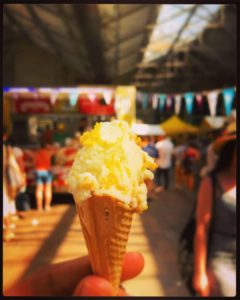
This week, however, I am going to focus on the Eternal City, as Rome is also known as. If you also decide to visit the Italian capital in the summer, here are my top 7 tips:
1. The Colosseum
No visit to Rome can be complete without a sight of the city’s most famous landmark: the Colosseum (or Colosseo, in Italian). From the iconic amphitheater, walk on the Via dei Fori Imperiali past the Roman Forum and towards the Piazza Venezia. Continue on Via del Corso. Now, you have a big decision to make: go either right to the Fontana di Trevi, or left to the Pantheon and the Piazza Navona.
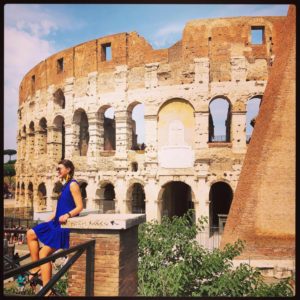
2. The trio of Fontana di Trevi, Pantheon and Piazza Navona
Fortunately, these three landmarks are so close to each other, that you can easily combine a visit to all three within less than an hour.
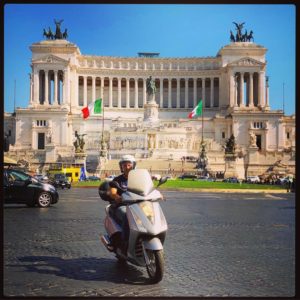
As you walk down Via del Corso away from the Piazza Venezia, the Fontana di Trevi will be on your right-hand side (whereas the Pantheon is on your left). Designed in the 18th century, this is one of the most famous fountains in Rome. Having featured in Fellini’s ‘La Dolce Vita’ and many more films, the Trevi Fountain is extremely popular with visitors from all over the world tossing their coins into the water.
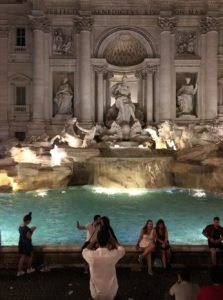
Built over 2,000 years ago, the Pantheon remains remarkably well preserved. This ancient temple was originally dedicated to the classical gods, but was later consecrated as a Christian church, and came to be also be known as Basilica di Santa Maria ad Martyres. Today, it is the most visited place in Rome, followed by the Colosseum, the Fontana di Trevi, the Capella Sistina (in the Vatican), and the Roman Forum.
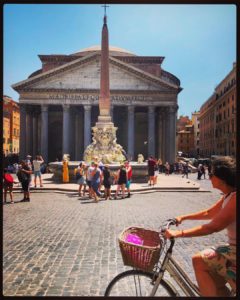
From the Pantheon, walk to the rectangular Piazza Navona; several fountains here attract a large number of tourists. Once you take in the views and the mandatory pictures, try to get lost in the surrounding streets, which are considerably less busy than the Piazza itself.
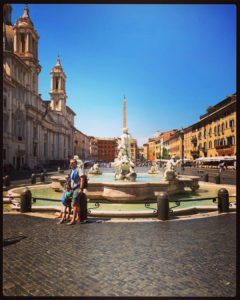
3. The Piazza di Spagna and the Spanish Steps
If, instead of turning right or left, you continue straight ahead on Via del Corso, you’ll meet Via dei Condotti (on your right) famous for its haute-couture boutiques. At the intersection between Via del Corso, Via della Fontanella di Borghese (on your left), Via Tomacelli (ahead and on the left), and Via dei Condotti (on the right), turn right on the latter and walk towards the Piazza di Spagna, another one of the city’s landmarks. Right before you’ll get there, you’ll pass by the historic Antico Caffè Greco (on your left-hand side). Having been there for over 250 years (since 1760 to be precise), it is considered the oldest café in Rome. Then, from the Piazza di Spagna, climb the 138 steps to the Trinita dei Monti church.
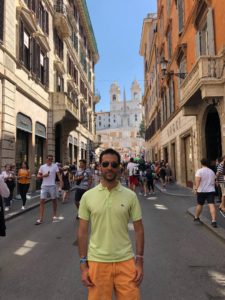
4. From the Ara Pacis to the Castel Sant’ Angelo
From the above-mentioned intersection, you can follow Via Tomicelli towards the Tiber and Ponte Cavour. Right before you meet the river, you will see Ara Pacis on your right. The recently opened museum (Museo dell’ Ara Pacis) contains the ancient Ara Pacis, or Altar of Peace.
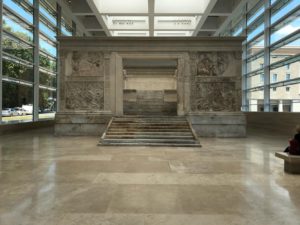
From there, you could walk along the Tiber towards Ponte Umberto I, and then towards Ponte Sant’ Angelo. On the opposite side of the river, there is the impressive Castel Sant’ Angelo, with the Vatican City not far behind. Also named Hadrian’s Mausoleum, this is a cylindrical fortress built during the 2nd century AD.
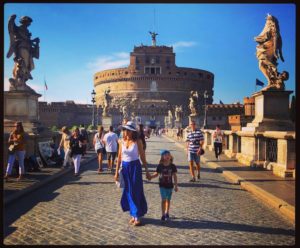
5. The Vatican City
The Vatican City, an independent country as well as the smallest in the world, is located in the heart of the Italian capital. It is the official residence of the Pope, and home of the Roman Catholic Church. It is also home to a population of about 1,000, as well as to a number of museums and ecclesiastical buildings. Of those, St Peter’s Basilica and the Cappella Sistina (Sistine Chapel) are the most visited. The latter is famous for its paintings and frescoes, and in particular Michelangelo’s Last Judgement. Overall, the Vatican City houses the world’s largest art collection, with over 60,000 works (including works by Michelangelo, Leonardo Da Vinci, Sandro Botticelli, and Gian Lorenzo Bernini).
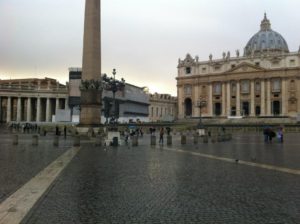
6. Trastevere
This beautiful neighborhood is situated on the opposite side of the Tiber (same as the Castel Sant’ Angelo), which is exactly what its name means. It is within walking distance from the landmarks mentioned above; yet, it is far less busy. From the Pantheon, walk towards the river, and then cross over Ponte Garibaldi. For me, the best time to visit Trastevere is the evening; you can combine it with a walk to the Parco del Gianicolo; sitting on top of the city’s highest hill, it offers panoramic views of Rome’s rooftops. Alternatively, Trastevere could be combined with a visit to the Vatican City, since both are on the same side of the river. Or, you can simply go to Trastevere for a leisurely walk, dinner, drinks, and of course gelato. For that, I would recommend the Gelateria biologica Fonte della Salute.
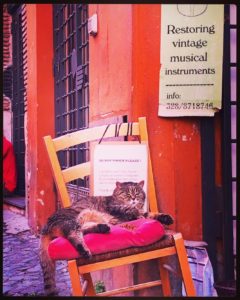
7. Coffee, food and gelato
Coffee
For me, coffee is part of the Italian gastronomic culture as much as pasta, pizza and gelato. In the summer, I am always opting for an iced coffee; in Italy, this has to be the shakerato. Usually served in a martini glass, it is prepared by shaking together a shot of espresso with ice cubes and syrup.
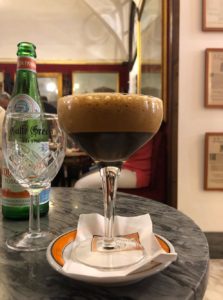
A coffee at the already-mentioned Antico Caffè Greco is a must-do. It may be rather pricey, but I simply have to do it every time I am in Rome.
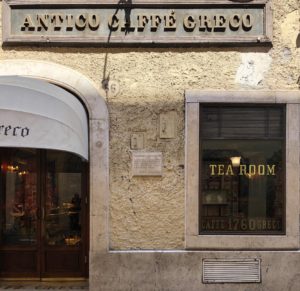
During my recent visit, I came across another great place for coffee: Sant’ Eustachio Il Caffè. You will find it on the Piazza di Sant’ Eustachio between the Pantheon and the Piazza Navona.
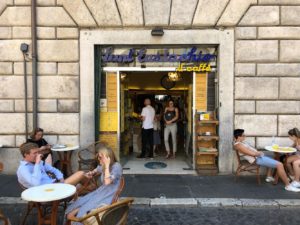
Food
As far as food is concerned, Rome is no short of restaurants. With that said, it is quite easy to fall into tourist traps and have not as good a gastronomic experience. To avoid this, I have 3 tips:
- Avoid the restaurants located in the most famous and touristy piazzas, or by landmarks (unless, of course, you are only keen on location). If you’d rather have a more authentic and satisfactory culinary experience, be prepared to walk to the back streets, and you won’t be disappointed.
- Avoid restaurants with the menu in photographs. The bigger the photographs the worse.
- Avoid restaurants serving fast food from different countries, i.e. burgers, kebabs, or English breakfast.
With that said, here are the 4 restaurants where I dined during my last visit to Rome, and I would highly recommend:
Ristorante Alfedo all Scrofa & the Trattoria del Gatto Bianco
In central Rome, a few steps from the Pantheon (and from the Gelateria Giolitti), there’s Alfredo alla Scrofa, and the Trattoria del Gatto Bianco. Located on Via della Scrofa and operating since 1914, the former is the birthplace of the famous fettuccine Alfredo, a delicious dish of fettuccine tossed with butter and Parmesan cheese. The Trattoria del Gatto Bianco on Via della Stelletta is not far from there; I had a classic pasta dish from Rome: cacio e pepe, spaghetti with pecorino cheese (cacio) and pepper (pepe).
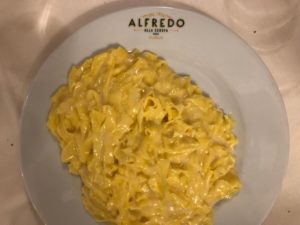
Ristorante del Giglio & La Grande Bellezza
Close to Roma Termini, the city’s main train station, there are two restaurants I’ve discovered previously and are now part of my culinary itinerary in Rome: Ristorante del Giglio and La Grande Bellezza. The former is on Via Torino, around the corner from Hotel Quirinale, whereas the latter is situated on Via Flavia (opposite Hotel Medici).
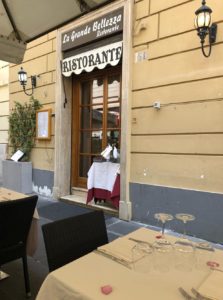
Dagnino
Last but not least, also near Roma Termini, there’s an excellent place for a light lunch, coffee and dessert: Dagnino. It is actually a Sicilian café-pasticceria, so expect arancini and cannoli. You will find it in the arcade Galleria Essedra, between Via Vittorio Emanuele Orlando and Via Torino.
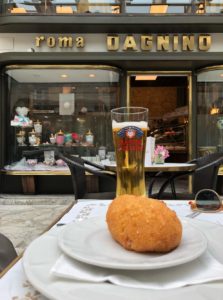
Gelato
Rome is no short of gelaterias either. In fact, they are so ubiquitous that you’re never going to get withdrawal from Italian gelato. If there’s one gelato you absolutely ought to try, then this is the Gelateria Giolitti, behind the Pantheon. I struggled to choose, as they have such a variety of very interesting flavors; in the end, I opted for fico caramellato (caramelized figs) and disaronno. And then I truly realized the meaning of dolce vita. As mentioned, in Trastevere, there’s the Gelateria biologica Fonte della Salute, where I had cocco e fichi (coconut and figs). There are also two of the most famous gelato chains, Venchi and Grom, with branches near Pantheon (for both), and on Via del Corso (Venchi).
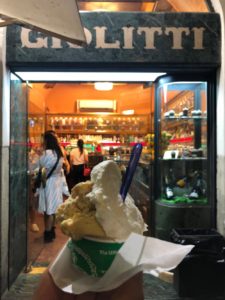
Prices
Most restaurant meals I had included a pasta dish, a glass of wine, an espresso, and water, and cost around 20-25 euros. Alfredo alla Scrofa offers a business lunch, including an antipasto, the famous fettuccine, tiramisu, an espresso and water; this costs 25 euros an is available from Monday to Friday. A gelato costs about 2.5 euros.
Getting to Rome
Rome has two airports: Fiumicino (Leonardo da Vinci) and Ciampino (G.B. Pastine). The former is the city’s main airport and also the main hub for Alitalia. The latter is a much smaller airport serving Ryanair and Wizz Air. From either airport, you can take a bus or a taxi to Rome, but only from Fiumicino you can take the train (serving several stations, including Roma Termini). The Leonardo Express train connects Fiumicino with Roma Termini, runs every 15 minutes, takes about 30 minutes, and costs 14 euros (one-way). If you take the train, remember to validate it; otherwise, you run the risk of having to pay a hefty fine. A taxi between Fiumicino and central Rome costs the fixed price of 48 euros (55 euros with luggage), so it’s worth considering for groups of 3 and more.
Accommodation
Hotel Quirinale is a 4-star hotel where I stayed during my most recent visit to Rome. It is conveniently located on Via Nazionale, within walking distance (5 minutes walk) from the main train station (Roma Termini), but also from many of the landmarks mentioned in this post (i.e. about 20 minutes walk from the Fontana di Trevi, the Piazza Venezia, and the Piazza di Spagna). I particularly enjoyed having an Aperol spritz in the hotel’s courtyard in the evening before dinner. Ristorante del Giglio is literally around the corner.
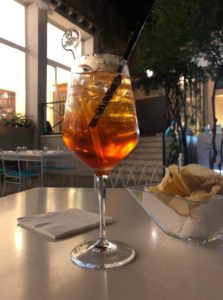
Another hotel where I’ve previously stayed is Hotel Medici, a 3-star hotel also close to Roma Termini. It’s opposite another one of my favorite restaurants, La Grande Bellezza.
When and how to long to visit for
Summers in Rome can be really hot, but there is definitely something magical about enjoying a gelato after midnight in front of the Fontana di Trevi, and searching for a reason not to spend the rest of the night on that very spot.
To visit the places mentioned in this post, you don’t need more than 2 days, but this will certainly not be enough to fully enjoy Rome and thoroughly experience the dolce vita. The more days you spend here, the better.
Further reading
There are many travel guides for Rome; however, today I’m going to recommend two books that will simply travel you to the Eternal City.
Angels And Demons
Dan Brown’s second novel, but the first to feature Robert Langdon, follows the fictional Harvard professor on a quest around Rome. As he tries to solve the murder of a world-class scientist and to prevent a terrorist attack, he unlocks the mysteries of the Illuminati, an obscure anti-Church brotherhood thought extinct. At the same time, Brown, with his unique story-telling, illuminates the Eternal City and takes the reader on an exciting tour around the Italian capital.
Eat, Pray, Love: One Woman’s Search for Everything
Elizabeth Gilbert’s memoir takes place in three different places, in each of which the author spent four months. Her journey starts in Rome, where, soon after the resolution of an unhappy marriage and a traumatic divorce, she learns how to enjoy the Italian cuisine and live life the Italian way. She will then travel to Asia, first to a spiritual retreat in India, and then to Bali.
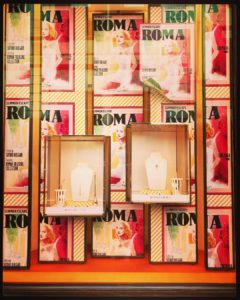
If you have enjoyed reading my tips and want to read more about summer destinations, check out my posts ‘Summer in London: top 20 tips by a local‘ and ‘9+1 Greek islands to visit this summer‘.
To follow my travels around the world, simply subscribe to the Traveling Psychiatrist (subscription button on the left-hand side).
My e-book ‘Greek Islands: Top tips by an (almost) local’ is available for FREE for every new subscription (for a LIMITED TIME ONLY).
Buon viaggio!
Alex
(the Traveling Psychiatrist)
4 Comments
Patrizia
A really true account of one of the most beautiful cities.
Thanks for writing it, I really enjoyed and it took me straight back to Rome.
Amazing pics!! ❤️
admin
Grazie Patrizia!!!
Pingback:
Pingback: